1071 Remnants of Sumas Mountain
ESSAY: Remnants of Sumas Mountain
by Natalie Lang
For those who came before and those not yet arrived.
*
And forever before me gleams,
The shining city of song,
In the beautiful land of dreams.
But when I would enter the gate
Of that golden atmosphere,
It is gone, and I wonder and wait
For the vision to reappear.
— from “Fata Morgana,” by Henry Wadsworth Longfellow (1873)
*
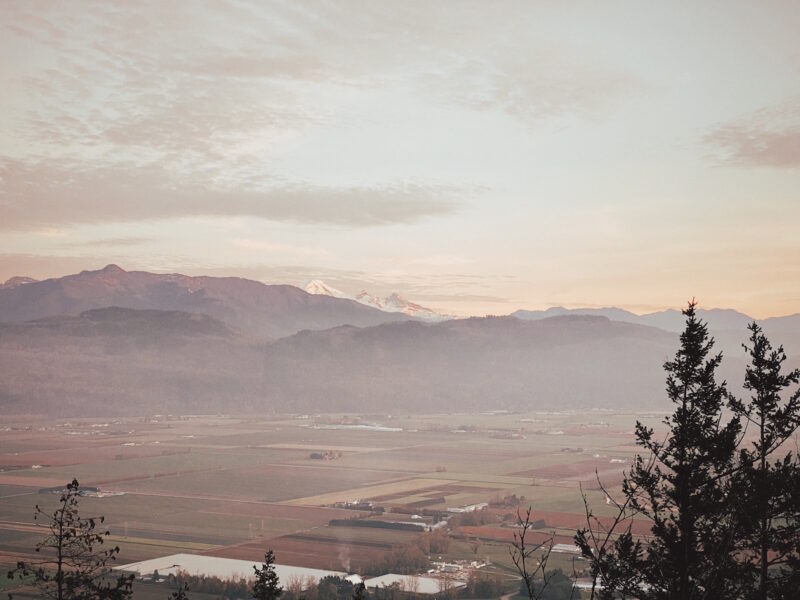
Spring
The sun crests early over the canopy, slowly warming the cool spring earth. A pair of owls call out to each other. Barely audible at first, the hoo-hoo from one to the next, then high, reached me in those quiet moments between sleeping and waking; a trace of something nearly forgotten and on the verge of being erased. I decided then, to take a walk in the woods.
Behind my family’s blue and white house and adjacent to a red Dutch gambrel barn with black trim, and set on five acres, there is a trail. It leads through a tangle of deciduous and coniferous woods, over a creek, and around a small waterfall, continuing on before branching off and looping in one direction then another, and circling back again; a network of soft earthen routes meandering to the corners of Sumas Mountain, about 70 km east of Vancouver and south of the Fraser River.
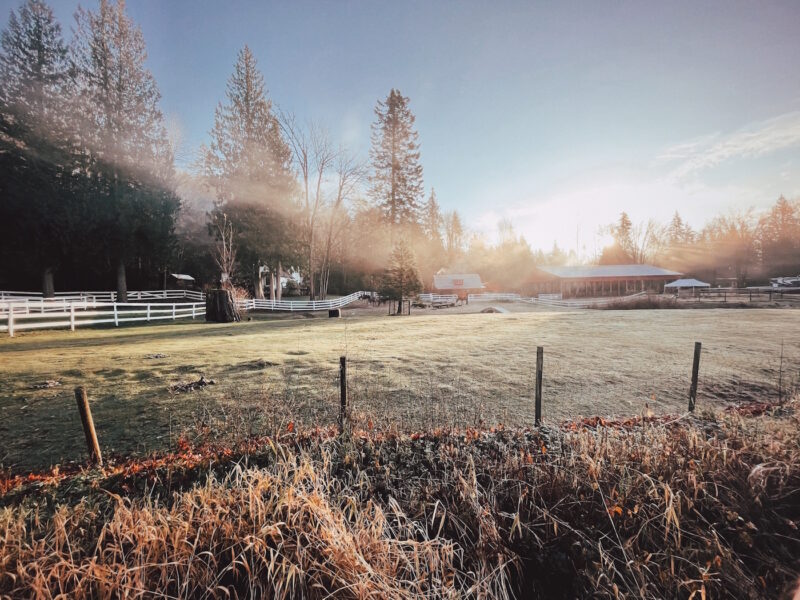

Slipping on my boots, I slide open a set of glass doors and step onto a moss laden red brick patio; an ongoing battle in this wet corner of the world. With a cool spring breeze at my back and the shy morning sun casting slim rays of warmth, I head East across a woodsy lawn, lightly strewn with remnants of winter debris, largely filled in with moss and clover and the first signs of yellow dandelions. We encourage the lawn to be whatever it wants to be, not tamed or sculpted, but beautifully wild in its own way.
Coming to a woodshed, I edge behind the stacks and onto an overgrown logging road, barely perceptible unless one knows how to see it. In just a few metres I step into the woods. The lush second-growth West Coast rainforest of Sumas Mountain closes in around me, abandoning, aside from the footpath leading the way, all visible traces of humanity, replaced by a low vibration of forest life.
It’s peaceful beneath the canopy; tranquil and unassuming. A deep breath allows the scent of fresh dewy air after a night of rainfall to intoxicate me. It permeates my bloodstream, running up and down the meridians of my body, forcing sensory reflexes to awaken; attentive to a complete body and mind shift that only this place provides. I tune into the rhythm.
Weaving along, up and down tilted hills, my boots step amid dark green ferns, over fallen logs, and around low hanging branches and debris, as the dull thrum of my heart beats with the pace of the forest. Along the edges of the trail, fresh greenery is budding. Soon there will be bursts of salmonberries and thimble berries; red, yellow, fuzzy, and smooth. I’ll share their sweet and tangy burst of nature with the birds and the bears.
I am conscious of not wanting to disturb the space any more than I need to. Aware of my presence as an interloper in such a complex ecosystem, I know that my being there is only a burden. Yet, this place opens up, welcoming me into its warm embrace, and helping me through the challenging nature of this life.
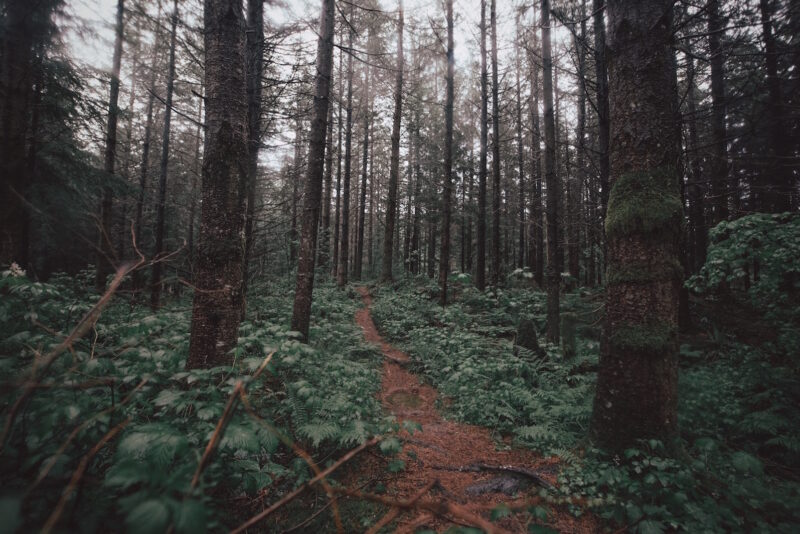
Slowly, I move among freshly uncurled baby ferns and tiny pink bleeding hearts whose pale blush colour is only just peppering the forest floor; their heads bowed in reverie. It would be easy to pass them by unnoticed. The chitter chatter of newly returned snowbirds pull my eye upward to search for the Northern Flicker woodpecker, or a chickadee. I remember a neighbour who shot a woodpecker with a B.B. gun because it would simultaneously peck a tree and call out to a long lost mate, just outside his bedroom window. I wince at the memory before my ears perk up hearing something resembling the tap-tap-tap of the red-headed bird somewhere in the distance. My eyes search in yearning but I never find her, and instead feel the guilt of humanity for what my neighbour did.
A slight downhill curve and a seasonal mushroom patch nearby, months yet to go before arrival, brings my attention once again back to the path I trod and then to a hand-laid bridge stretching over a wide gurgling creek. Crowded, the water rushes down the mountain, away from its source, and toward the destined home it craves to be near. Pausing here, I take a long sweet breath. In through the nose. Out through the mouth. Shoosh. Inhaling the slight misty air of the babbling brook alongside busy beaks of local gossiping birds and giggling chipmunks watching me with caution, I feel like a part of the woods. Trees that shiver in the slight breeze, lean toward each other in quiet whispers of last night’s secrets and I am thankful to be a part of their counsel. Crouching down, I look into the water rushing beneath the bridge and feel it glisten with shadows as each ray of morning light filters through the nearly translucent green forest. It is spring time on Sumas Mountain.
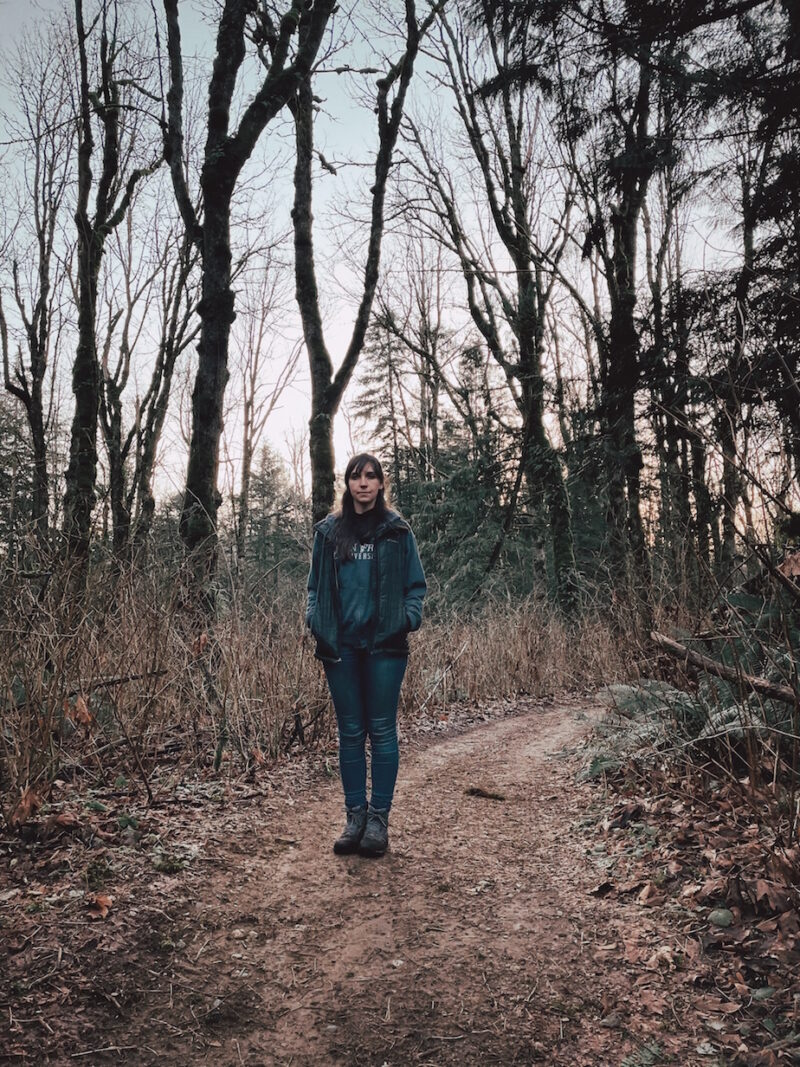
If I remain on the bridge long enough, suspended over the water, remnants of my past come rushing back. I can see myself as a small girl dashing through the trees. I am a mountain goat and a forest nymph. I am an explorer. I am one with the woods; a woodland fairy fiercely loving and protecting the wonder of this place. I see my father, in one moment, clad in torn plaid and well worn boots, collecting wood for our fireplace from a tree blown over in a recent windfall. In the next moment, he is walking alongside me, then suddenly stopping to inspect the gills of a mushroom, or the bark of a tree, or to remove a fallen branch from blocking our path, all the while telling tall tales filled with half truths. I also hear my mother’s voice, warm and calm, teaching me that we are guests here and that we must be as minimally invasive as possible. That is the only option for being here. I learned that we may explore and play and experience all that this beautiful place presents, as long as we work to protect it.
“We need to leave the frogs where they sit”, my mother told me when I tried years ago to bring one home to add to our very empty pond. “If a frog wants to be in our pond, that’s his choice. But we don’t get to displace him just because we want to,” she said. These were the lessons I learned. It seems, though, that the world at large doesn’t always have a mother like mine.
When fewer people lived in this area, before developments began to creep up the mountain like the slow onset of disease, this corner of the world was an oasis. Perhaps it could have stayed an oasis if we had kept it from the progress that seems so inevitable. I suppose, though, even I was part of that disease. Before me, my family and our neighbours, there was another understanding of this place that we had encroached on. Now, the trespass continues.
Returning to the present, I step off the bridge, saddened that the rocks I used to hop so lightly on to cross as a child sit in the dark below, and continue along on my morning walk. The original path my father built over thirty years ago now branches out into a web, each line leading away from the first and connecting to another and another. The unsanctioned trails behind our house are no longer small and few. I recall, before the bridge, before the people, before the many other trails, just one loop that went behind the woodshed. A sure-footed jump from one rock to the next and the next took us cross the wide bubbling creek, and the path meandered to the East toward a waterfall, then South to where the trilliums grew, then West toward a high ridge and a hidden pond, and back again to the creek and home.
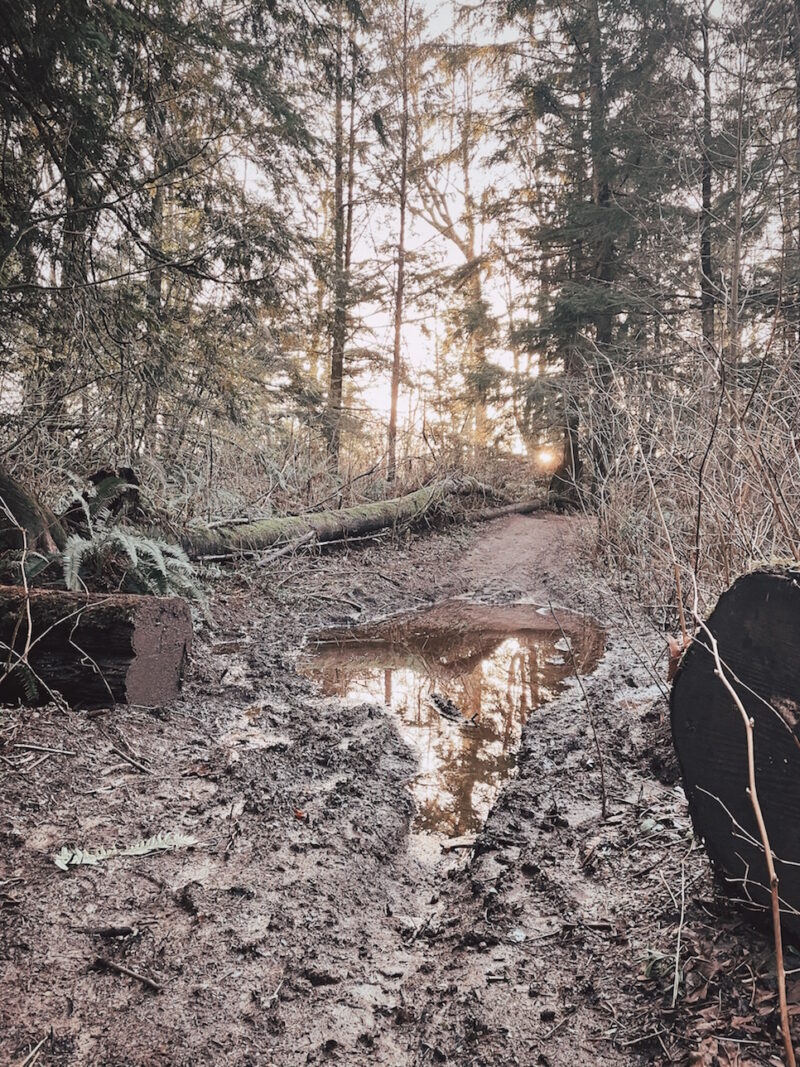
Now, there are many more trails. Wider trails. Muddy trails. The ground has been chewed and pitted. First by mountain bikes, who grew bored at the limited range. Then, by motorbikes looking for a quick thrill. Now, four wheeled motorized quads rip through from one end to the other, whipping around the original loop and onto one of many more, their riders thoughtless of the negative effect. In a few short years, small narrow footpaths grew wider and wider. Tire tracks dissolved the soft earth, leaving many sections of ground with a bog-like consistency. A calm peaceful walk among the birds and whispering trees, became one avoiding deep divots of muck, the echoing of gravel mines drowning out the pulse of the forest, and a fearful query that wondered, what new assault on the senses would I experience today?
In the West, where rugged shores meet rugged land and mountains groan under the weight of snowy caps, where a wildness overtakes the people, there are remnants being erased in the pursuit of progress. While some stories and places, deemed economically valuable are preserved, other pasts are rewritten and rewritten, taken apart and built back up again. Each time, what was created or remembered is stripped bare, all its pieces chipped away until eventually there is nothing left but cold newness. New people, new structures, newly divided land, and a weakened heart at the centre.
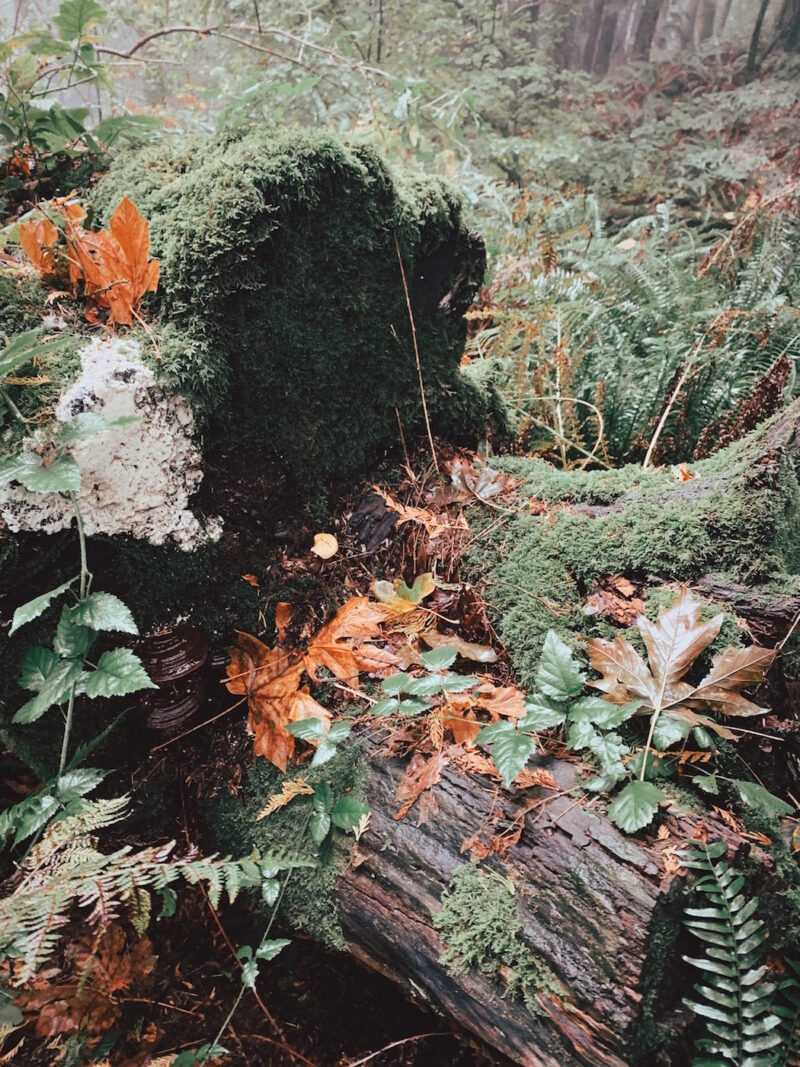
I come next to a three pronged fork in the path where a few years ago a young tree had been hacked down by some unknown visitor, leaving a crude stump in its place. The centre of the tree sticks up in jarring spikes suggesting the tool of choice may have been a small, dull, hatchet. It would have been a slow death. My body grows heavy seeing the remnants of the tree turning green and black as it adopts a new stage of rot. To the right of the stump I notice a small white plastic baggie tied up neatly and tossed alongside the trail. A printed outline of a smiling dog is just barely visible from where I stand. Something dark and brown is contained within.
I recall Marcus Aurelius who once cautioned to “Leave the past behind, let the grand design take care of the future, and instead only rightly guide the present.” Are you right Marcus? What if leaving the past behind is the path to complete erasure of important remnants? What came before is what makes the present and creates the future. I worry about the future being created by those who discard bags of dog doody onto the forest floor. I pick up the bag, no longer warm, and carry on, doubtful, but hoping, I’ll come across the culprit. I never do. Instead, I bring the bag home with me and put it in the trash.
In this modern world, a blindness for growth has bastardized the integrity of place. A place is not only where one lives, works, visits, or seeks to gain and grow from. It is a memory. A living memory, just as much a part of the past as it is the present and the future. It is a testament and remnant to culture, history, change, suffering, and to those stories of people and land that were built and dismantled before and will be built and dismantled in all the years that follow. A place is where a family builds a memory. It is where the earth breathes. It is where life grows and changes among the whispers of the tragedies and joys of being alive. It is the imperative of the modern world, struggling to find a foothold while the planet swirls in a cloud of chaos, thicker by the moment, to value place in its purest form. Sifting through perspectives that broaden or narrow our minds in how place can be seen, experienced, and developed is perhaps where the answers to my struggles with the changes on Sumas Mountain lie.
*
Don’t it always seem to go
That you don’t know what you’ve got ’til it’s gone?
They paved paradise
Put up a parking lot
Shoo, bop, bop, bop, bop
Shoo, bop, bop, bop, bop…
Joni Mitchell’s “Big Yellow Taxi” comes to my mind from some untraceable tangent of memory. It’s melodious and upbeat tune bops along with each step I take, matching up with the humming and singing; shoo, bop, bop, bop, and then don’t it always seem to go. I jaunt along and speed up my pace as Joni’s bittersweet voice brings me back around the trail, heading for home. I do know what I’ve got, but I may be powerless to stop the coming progress before its gone. I think about what this area would have been like. Before me. Before my family. Before the first and second batches of mass and pocket logging. With each step that takes me closer to my family’s property, I hear the whispers of the past. Whether its on the curves of the wind, or the rustling in the trees, or the traces of logging roads reclaimed by the woods, or the vibrations emanating up from the roots in the earth below, I think back to my family history, and then to the history before us. It seems we are all powerless to stop what has perhaps been inevitably on its way.
*
Nature’s first green is gold,
Her hardest hue to hold.
Her early leaf’s a flower;
But only so an hour.
Then leaf subsides to leaf.
So Eden sank to grief,
So dawn goes down to day.
— from “Nothing Gold Can Stay,” by Robert Frost (1923).
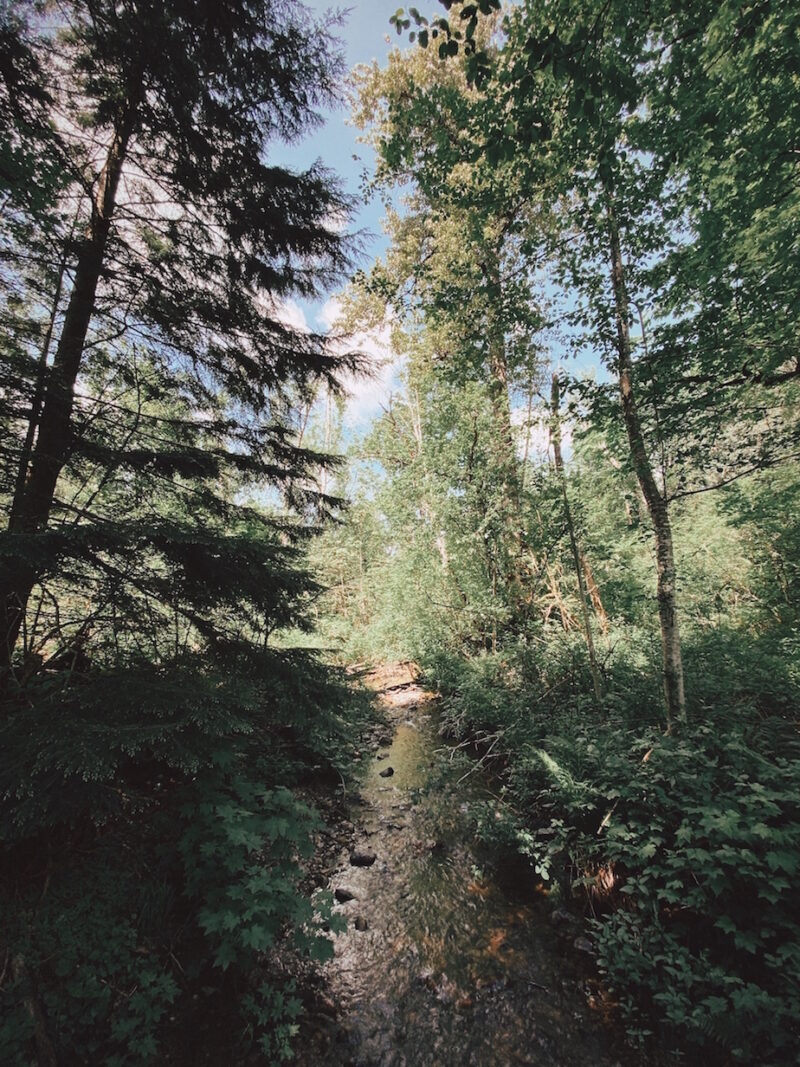
Summer
Summer on Sumas is as close to paradise as I have ever known. The forest sings with the abundance of life amid greenery so thick that at first glance the forest seems impenetrable. Bees busily bustle about collecting nectar, pollinating flowers, too busy to think about the slow decimation of their population. Barn swallows and their descendants who return each year in the spring are teaching their babies to fly by the early summer; managing the mosquito population as they swoop and tumble through the air like nature’s original Cirque de Soleil acrobats, taking breaks along white fences and looking like thugs with their wings hunched up into absentee necks. The mountain has a fullness that only a boreal rainforest can produce. Even the assault of the gravel mine nearby, or building of new houses, development of subdivisions, and repaving of roads, is muted by the cacophony of warbling birds, summer storms, long hours of warm sunlight, and the forest that breathes greenery into every molecule of my body.
On the hottest days of the year, when the air stands still and those long hours of sun that West Coasters wait desperately for suddenly becomes too much, I can still take a walk along the reclaimed logging road and meander down the footpath. I can ignore the wide rutted parts of the old trail and the screaming motorbikes and quads and can remember what this place was like as a child. When I visit my favourite group of trees, count the Easter Lilies hiding in the undergrowth, or sit among the now trickling summer creek, whose water slows to enjoy every moment of its descent down the mountain, not in quite the same rush as it is in Spring or Fall, I feel the magnitude of interconnectedness and beauty in this place. Yet when walking on this trail or any other path disappearing from road sides or backyards into the woods, in spite of so many other aspects to see and connect with and the ability of the fullness of the forest to largely mute sounds of humanity, a rush of noise, pieces of garbage, a stranger walking and talking on their cell phone who doesn’t look up, or a dead squirrel lying on the path, causes the tumbling facts of reality to crash into me.
A few years ago, with the heat of summer creeping closer to peak temperatures, critters were found dead on Sumas Mountain with no initial obvious cause. It was eventually discovered that some homeowners did not want wild critters infesting their property and therefore squirrels, rabbits, birds, mice, and an unsuspecting neighbour’s dog became victims of poison. They’d eaten bait left out along the perimeter of properties, or eaten something that had eaten the bait first, or eaten something that had eaten something that had eaten the bait, and so it goes. Whatever participated in this natural chain of mealtime, was no longer welcome in the land of the living.
Enraged by the complete lack of consideration for life, and not understanding how one could not know that we are here as guests and custodians, I did what any activist might do to bring awareness to a pertinent issue. I made posters.
Printed on 8×10 white cardstock, were various silhouetted images of critters that may be found in anyone’s backyard; a squirrel, a rabbit, a chipmunk, a mouse, a skunk, a raccoon. Next to the blacked out figure and inside a red circle with a red line running through it, was written the word, Poison. Below all of that was:
This is their home too.
Don’t poison the wildlife.
Rather proud of myself, I posted these in high traffic areas. That meant, the mailboxes at the intersection of Dawson Road and Sumas Mountain Road. In the morning, heading out to start my day, I posted them in each of the designated posting bulletins, as per the rules. By the afternoon, they were gone. Confused, I printed and posted more. The next afternoon, again, they were gone. This only fuelled my frustration and each day for the next few weeks the battle of the posters raged on. I envisioned myself dressing in black and parking in a discreet area, waiting for the senseless individual to appear so I could ask what their problem was. This plan turned out not to be necessary. Either my opponent grew tired of the game, or learned their lesson, but in the end I won. A single poster remained, and remains, sleekly slid inside a plastic sleeve, pinned to a bulletin at the mailboxes.
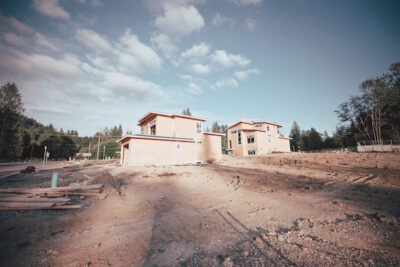
The rest of that summer, as has been the case over many summers in recent years, the growth and development expanded. Although, the magic of Sumas Mountain still seemed to heartily prevail and one could easily participate in the abundant recreation activities and enjoy nature with little thought of the onslaught of progress. From day hikes, to mountain biking, swimming at Lost Lake, eating the last of the Salmon Berries before they were ruined by summer heat, savouring food from backyard gardens, and smelling wild roses along trail paths, or looking for the vanilla leaf plant whose scent permeated the essence of the woods, its almost enough to forget that subdivisions are going in with gates and fences keeping the outside out and the inside in. Its almost enough to overlook entire sections of mountain that have disappeared into the ashy grey of a gravel mine.
A 10×6 sign marking the first subdivision ever built on Sumas Mountain still stands at the corner of Whatcom and Sumas Mountain Road. Faded and leaning slightly to one side, one wooden leg attempts to keep the sign straight while the other has begun to sink into the ground. I drove past it one day, with a line of cars trailing behind me, and the letters and images that were once bright and vibrant, advertising for the greatest and most collective mountainside community ever built in British Columbia, had faded to reveal what seemed to be a set of eyes framed by circular wiry glasses. At first the eyes honed in on me from within the sign as I drove up to it. At second glance, passing by, they were gone and only the faded grey of the sign remained.
*
Who robbed the woods,
The trusting woods?
The unsuspecting trees
Brought out their burrs and mosses
His fantasy to please.
He scanned their trinkets, curious,
He grasped, he bore away.
What will the solemn hemlock,
What will the fir-tree say?
— Nature, Poem 17, by Emily Dickinson (1896)
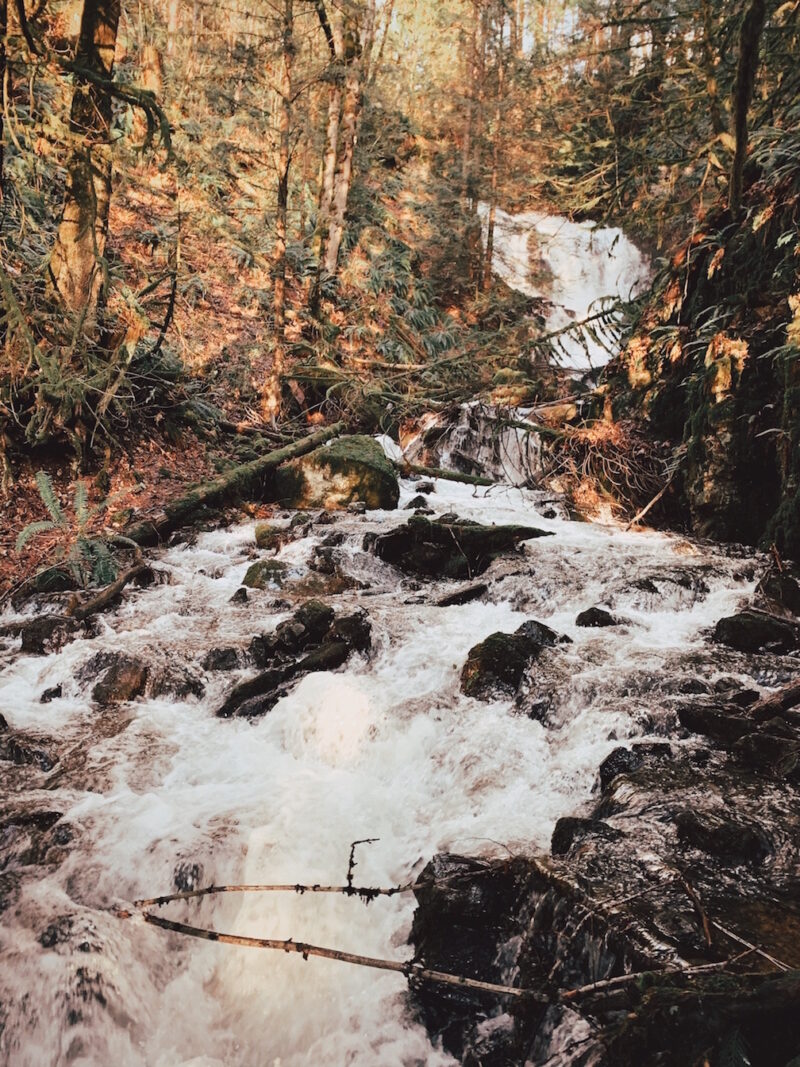
Fall
There are some spots left on Sumas Mountain where forests are abundant, the presence of people are scarce, and even some ancient old growth trees still stand, hidden from view with secrets and tales of the past; another world entirely from the one creeping up and around the the modern reality of the mountain. One morning, in early fall, John Vissers, an active 60-something neighbour who has seen me through all the stages of my life, took a walk with me to find the last patches of old growth trees on Sumas Mountain.
John lives in the third house on the right on Charlie Spruce Place. Refusing to bring in much fill to build up his property, going over to the Vissers’ is like wandering through Narnia. It’s likely that fairies drink tea under toadstool mushrooms, and harmless creatures watch from the looming trees lining the property as you walk by. Near the swampy pond behind the house, and along mossy laden undergrowth, there is a soft quietude that permeates the awareness of any visitor willing to pay attention.
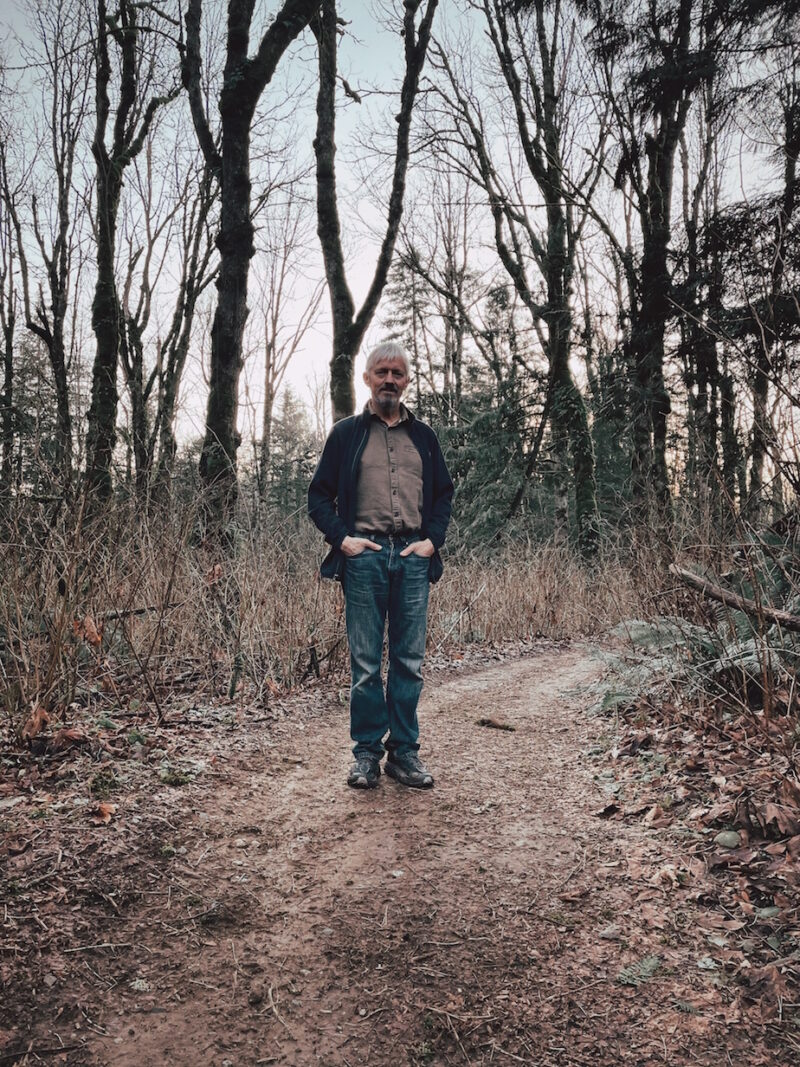
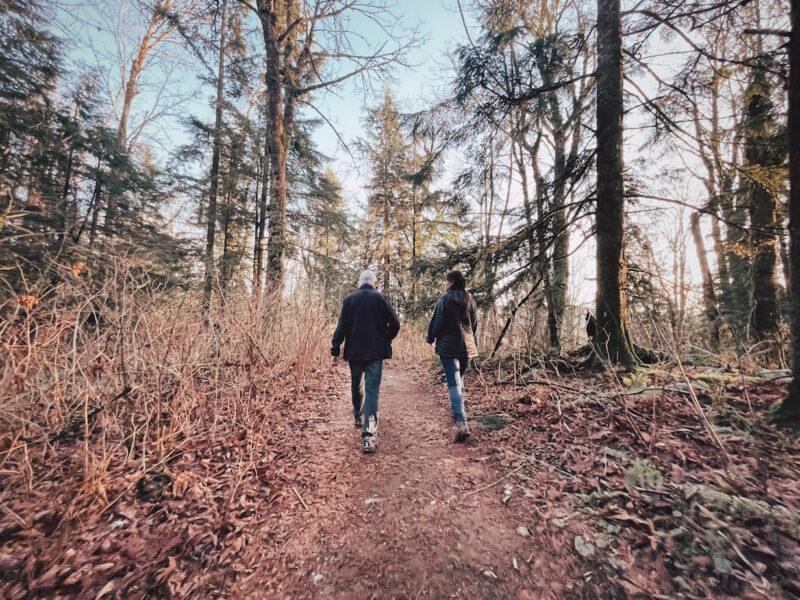
On a misty cool Sunday in early October, my electric car and I picked John up at the mouth of his driveway. With a slight and wiry build and hair that seems more white with each greeting, John is an unassuming character with a humble wealth of knowledge of Sumas Mountain. It had rained profusely all night and today we anticipate it will rain again, but like any good West Coaster, we go out into the woods anyhow.
From Charlie Spruce Place, we take a left at the stop sign and coast down Dawson Road to the four-way intersection where Dawson meets Sumas Mountain Road. To the left is a new subdivision going in on land that once housed a bright yellow one room school house. It was built when the area was settled in the early 1900s after clay had been found and micro-communities and homesteads popped in and around the mountain; at Kilgard at the Southern base of the mountain, at Clayburn on the Western base, at Heritage Valley where a mining track once reached a local terminus, and at Straiton Village, named for Thomas Bell Straiton and his family. The Straiton Community Hall is all thats left of the Village. What once was a collection of large properties, a post office, a general store, a school, and community centre, located in the opposite direction of where John and I are headed, is now a series of subdivisions, an oil refinery, and a gravel mine. I remember the day they tore down that schoolhouse, along with the trees, and grassy knolls that made it a home long after the school had closed. Like a shock to the system, I drove past where it stood one afternoon, feeling something was missing but not knowing what until I glanced in the rear view mirror to see the remaining shards of yellow wood piled next to a wrecking ball and a dump truck. One day it was there, and the next it was gone. They named the street that goes into the new subdivision, Diane Brooke. I’m told its named after the creek that runs in the ditch alongside Dawson road. I wonder if those who live there now will ever know a school house and real interconnected community once flourished here.
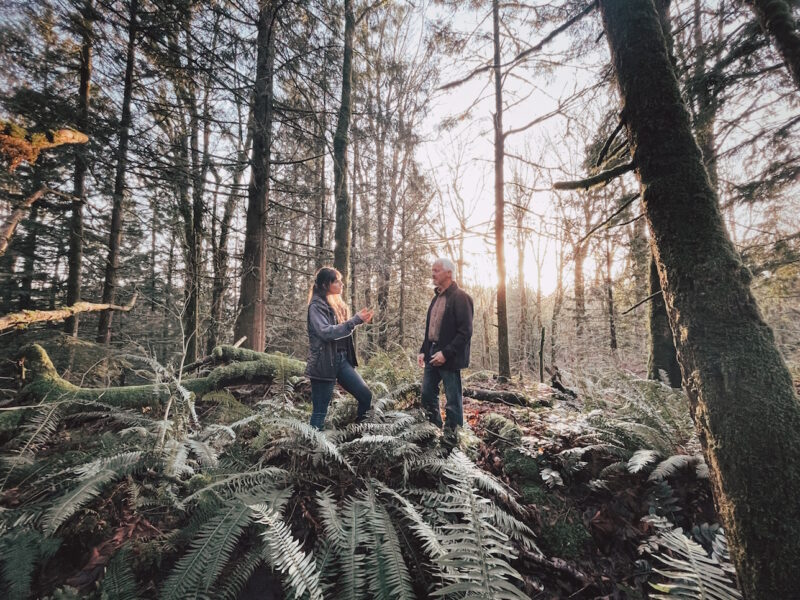
John and I turn right, heading North up Sumas Mountain Road and away from the lost remnants of Straiton Village.
Ten minutes along our way, going up, up, up, we pass many homesteads and remark on families whose ancestors have lived on Sumas Mountain since the beginning, and on new builds with neighbours who install tall gates and high fences.
When Sumas Mountain Road winds along a crest in the mountainside, then turns downward, the pavement shifts to gravel. We drive briefly down the backside of the mountain, toward the Fraser River before pulling a u-turn where the road widens at one side, and park along the North-West edge. Known in another life as Wade’s Trail, Sumas Mountain Road is the modern incarnation of the first route that wound from one side of the mountain to the other. It was the only way to get from the Fraser River to the Sumas Border as the surrounding area at the base of Sumas Mountain was swamp and marsh. Before dykes, drainage, and pumps were put in to make the land suitable for farming and development, the river flooded each year making the base of the mountain entirely unpassable, even for the Sema:th people who lived, hunted, and traded in the area. As a result, trails were carved over the mountain, not unlike the one that John and I are about to embark on in search of one of the last remaining pockets of old growth trees on Sumas Mountain.
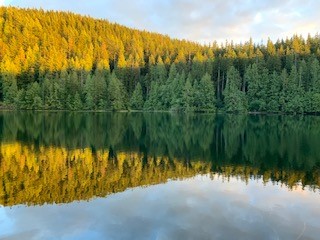
Built in 1967, the Centennial trailhead originally started further down near the base of the mountain. It was the project of retired loggers and locals, eager to create something in appreciation of the spectacular beauty of this area. Time, circumstances, tree lots, logging, purchasing of land, and the creation of park boundaries caused the route to change over time. It went out of service for many years before being rekindled and rerouted into the modern way that we are venturing out on. Today the trail avoids some unsafe sections that once took hikers past “lover’s leap” and other deadly cliffs. Much of the trail, though, still follows the original logging roads that made their way up to the top at Lost Lake. The trees were once all so massive, some measuring fifty feet around, that when logged they were driven down the mountain one at a time.
Slinging our packs across our backs, and crossing the gravel road from where we parked, John and I step onto the trail, passing a notice that indicates there are bears and sensitive habitats in the area. A metal box is stationed on a post with a counter inside, tracking the number of users entering this area each day. We cross the threshold and into the woods.
Marching up Sumas Mountain with John is a bit like trekking into a wild place with a mystical creature. His words are filled with wisdom and experience, excitement and colour. He holds an insatiable optimism and appreciation for Sumas Mountain, and in spite of its sordid past, developments, and some attitudes against preserving it, he believes it will be okay in the end because there are those who wish to protect it.
My mind relaxes as we begin to walk through the deep green and fiery orange forest. I breathe in the drizzling October air, heavy with misty particles as ancient as the area itself. The ground is soggy, sending mud to trace the outlines of our boots. Water trickles down the path in many places and we know, in spite of the smart footwear we chose that day, our feet will be damp by the end of our adventure. The damp doesn’t matter to us. We are looking for one patch of old growth trees that help to make up part of the less than two percent of old growth left standing in all of British Columbia; wet feet are an afterthought.
Among these hidden sentinels, Sumas is also home to a collection of unique creatures. Crossing a wide bridge, water crashing into rocks and mountain above, below, and under us, John is animated with excitement. He tells of the day he and a group of researchers found a Red Tailed Frog in the creek. “We didn’t think we’d find any!” He exclaims. “It was right over there!” He says, pointing to the south side across from where we stand on the bridge.
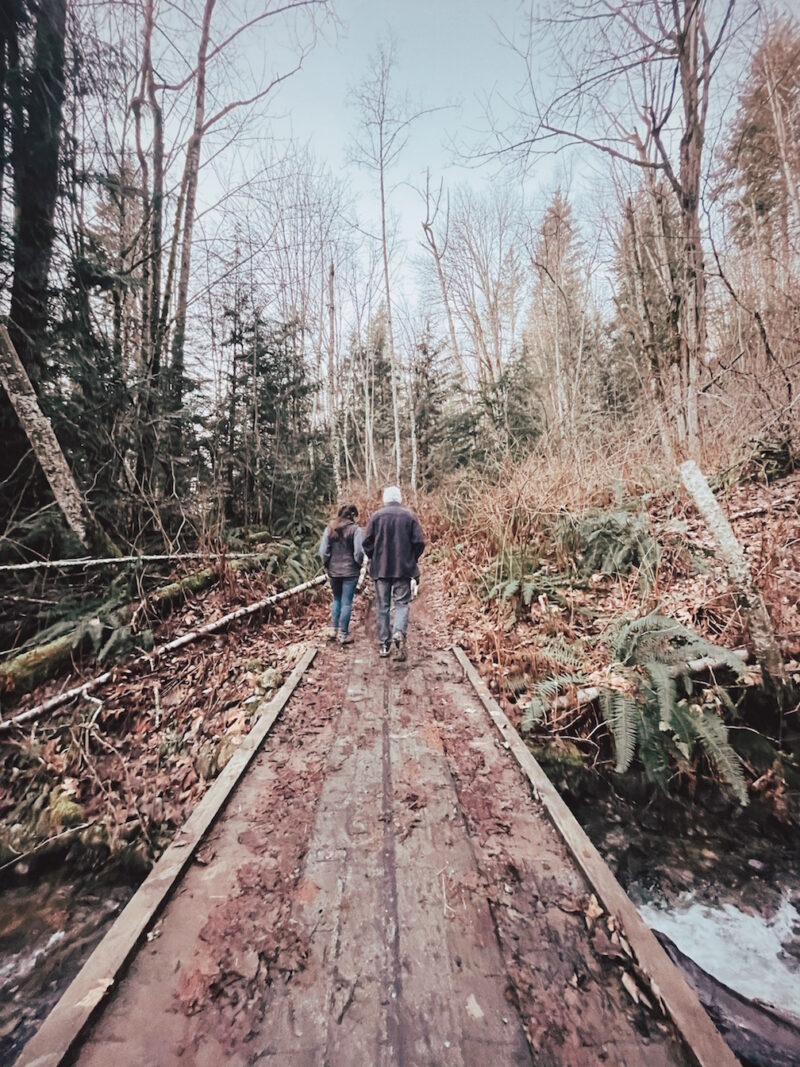
John tells me that Sumas Mountain is a microclimate that sits at the Northern edge of a larger and more biodiverse area, home to many species. The edge of a species’ bubble is where the most genetic diversity exists, allowing the species to be collectively healthy. “These are what we call,” John says as we step off the bridge and back onto the wet and narrow footpath, in his usual colourful tone, “keystone species.” He goes on to point out as we walk that many might wonder why the protection of a species here even matters, if it exists in other parts of Western Canada. “The problem arises,” he says turning slightly to talk to me as we continue up the trail, “when the edges of a large biosphere start to fall,” due to climate change, invasive species, or general human existence, “over time a new edge falls, and another, and another.” On and on it goes until the entire species as well as others dependent on it, tumble like dominoes.
John’s passion for this place gives me pause. I wonder about the trails and spaces around my family’s property back on Charlie Spruce Place, and mourn the loss of the yellow schoolhouse in what is no longer Straiton Village. I also wonder what it was like where we are walking now, at the tip of Sumas Mountain, before the Centennial Trail was built. I know this forest does not look like what it did, before loggers and settlers and miners came up the river from New West Minister and landed at the base of Sumas Mountain, wandering up Wade’s Trail, and claiming large swaths of land for the price of the paperwork involved. I try to picture what the space would have been like. I look around me as we hike, listening to the whispers that dance through the trees and along the bottom of trickling waterways. With each step, growing heavier with memory, I attempt to see the past through the wet foggy air closing in around us as we ascend.
About an hour into our hike, we pause at a bend. The trail goes East, but we are headed West into the thick, off trail, to find the last grove of ancient trees left behind. I take a long drink of water and John and I turn in the direction of an entirely different form of forest.
Gingerly stepping off the path, careful not to disturb the undergrowth, we take two separate routes through ferns, around rocks, past stumps and fallen debris. John continues to chat. He talks briefly about the difference between old growth forests, planted forests, and logged forests that had been given time and space to repopulate themselves. Most of Sumas Mountain’s second or third growth forests had been allowed to come back on their own. In doing this, the death sentence of being a mono-culture is avoided; a crop planted entirely subsisting of one type of tree, growing up much like a cornfield where biodiversity is largely non-existent. The trees in a mono-culture aren’t as healthy as other forests. Like the falling edges of a biosphere, the entire area lacks the diversity necessary to protect it from disease, pests, and forest fires.
At the crest of a small hill, the path we left behind fading into the backdrop, the sight before us is the entry into another world. Thousands of enormous ferns fan out along the ground. Stepping in among them, it is difficult to know where the ferns end and the ground begins. I walk slowly, following John’s confident lead, fearing my boot may discover a hole and I’d be lost amid the forest floor, doomed to sleep in the underbrush of this strange transitional terrain.
Beyond the ferny plateau, a large maple has fallen, its burl had been poached and the tree left for dead. This is the gateway marking the entrance to a forest that looks quite different from where we started. I am drawn inward, toward the depths of the woods, seeking whatever quiet power has transfixed me. Then suddenly, the fog and mist that had been following us upward, lifts and there in the close distance, stand a dozen enormous Fir trees, the grandmothers of a forgotten world. A profound silence permeates the space, taking up residence in the very air I breathe.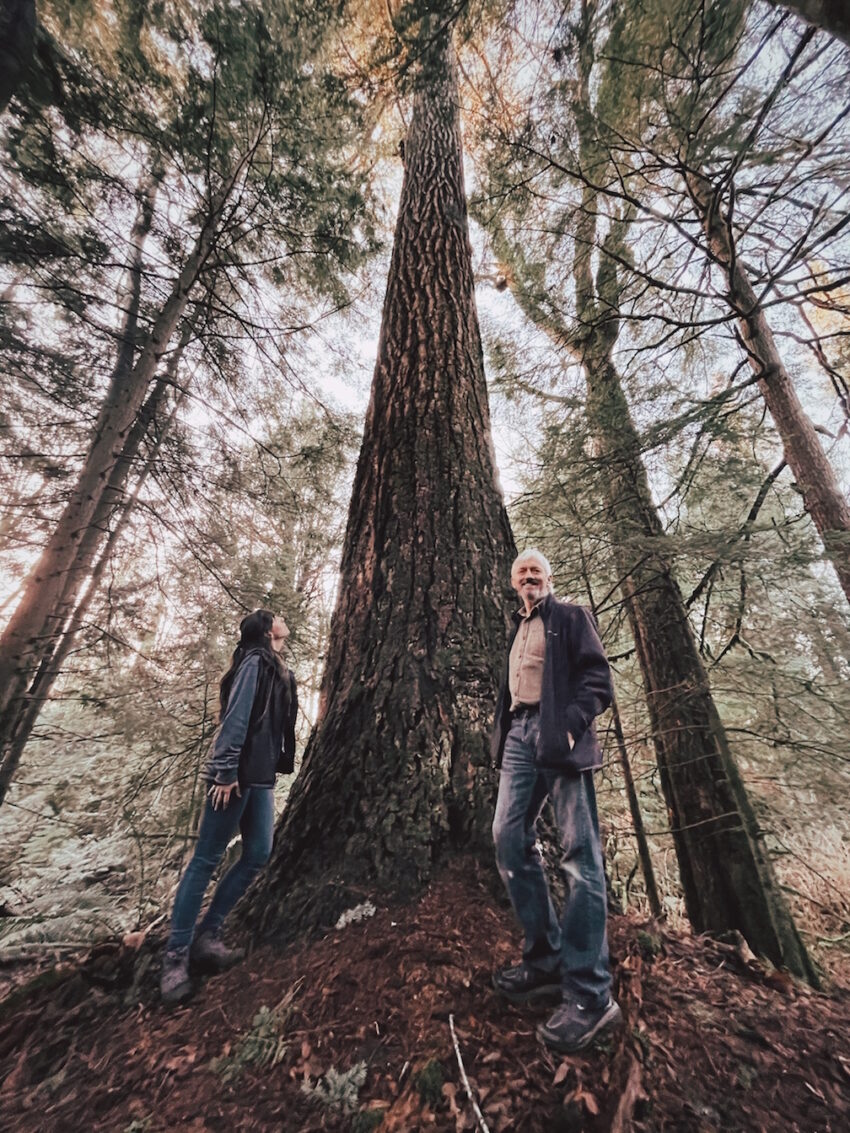
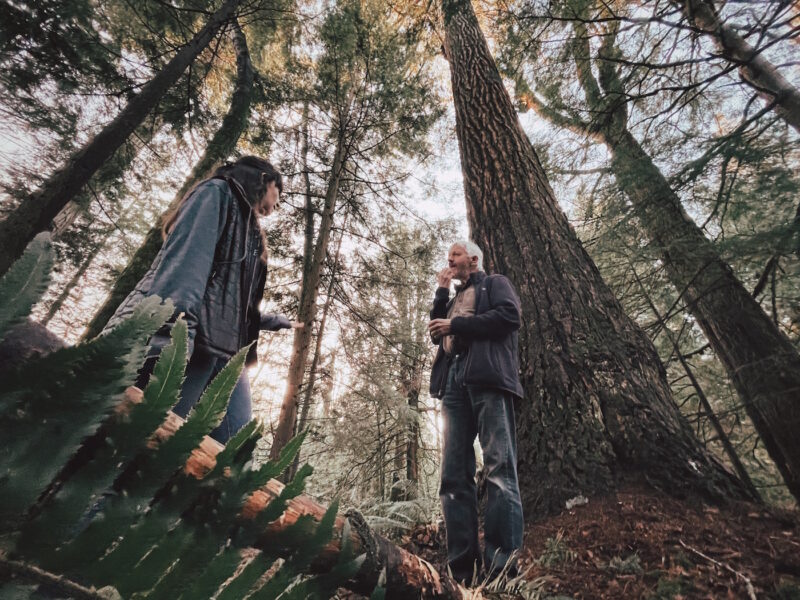
Stepping into a depression, surrounded by the looming sentinels, the mountain seems to change. The light filters differently and a mist settles slightly askew; its particles drifting in a barely perceptible breeze. The canopy above is vast and grand, while the foliage below is open and airy. There are no brambles to walk over and around, there are no stumps or debris, there is no thicket blocking the way. There is only the same earth from when this mountain was first born; unchanged and untouched. I close my eyes and breathe. The sweet scent of fall, decaying leaves, damp moss, and a cooling air, pervades every sense. Hearing a shuffling next to me, my sight returns to see John marching toward one of the massive Douglas-firs. Watching him, in this ancient forest, I feel at once out of place and completely at home, as if we had entered into another realm that had been lost to the past, waiting to be rediscovered. We’d walked through a portal to a time when giant Cedars and Douglas-firs were bountiful and majestic; entire cities of trees with an interconnected network of conversation and understanding. I feel their presence so absolutely, looming over us like great storytellers, waiting patiently in the mist for their tales to be told.
John looks at me, and then looks up at his tree. I ask him why it feels so good to be here and why, regardless of effort, I am never quite at ease in the same way anywhere else. “Cultural experience versus natural experience,” he says. Perhaps we are instinctively hard wired to feel good in the forest. “You can’t stand next to a tree like this,” he continues, his gaze climbing the massive Douglas, “and not feel some kind of emotion.” He goes quiet for a moment, his head tilted, before explaining that in experiencing this place, we have an opportunity remember there are other ways of being. We can see that trees are not like us, but maybe we can learn to be more like them. Maybe we can learn to be a community, to work together, to help each other grow and develop in a powerfully sustainable and aesthetically beautiful way, taking lessons from the remnants of the past.
In spite of the spitting rain, soggy ground, and my damp feet, on this October Sunday the overwhelming beauty of the forest is astounding. The grove of remaining giants, left behind perhaps because they were too small to log at the time, or loggers got all they needed, or the Great Depression hit in the 1930s and these trees were no longer worth the trouble, stand still and quiet, a remnant to a time gone by. They hold the secrets and the stories, the joys and the hurts. If I stand still long enough, letting their voices hum around me, perhaps I can hear them whisper. As archetypes of an ancient world, the Grandmothers tell of their lost brothers and sisters, and Opa, the largest and oldest Fir of the bunch measuring thirty feet around, overlooks the entire forest calmly and with great wisdom, like any great grandfather should.
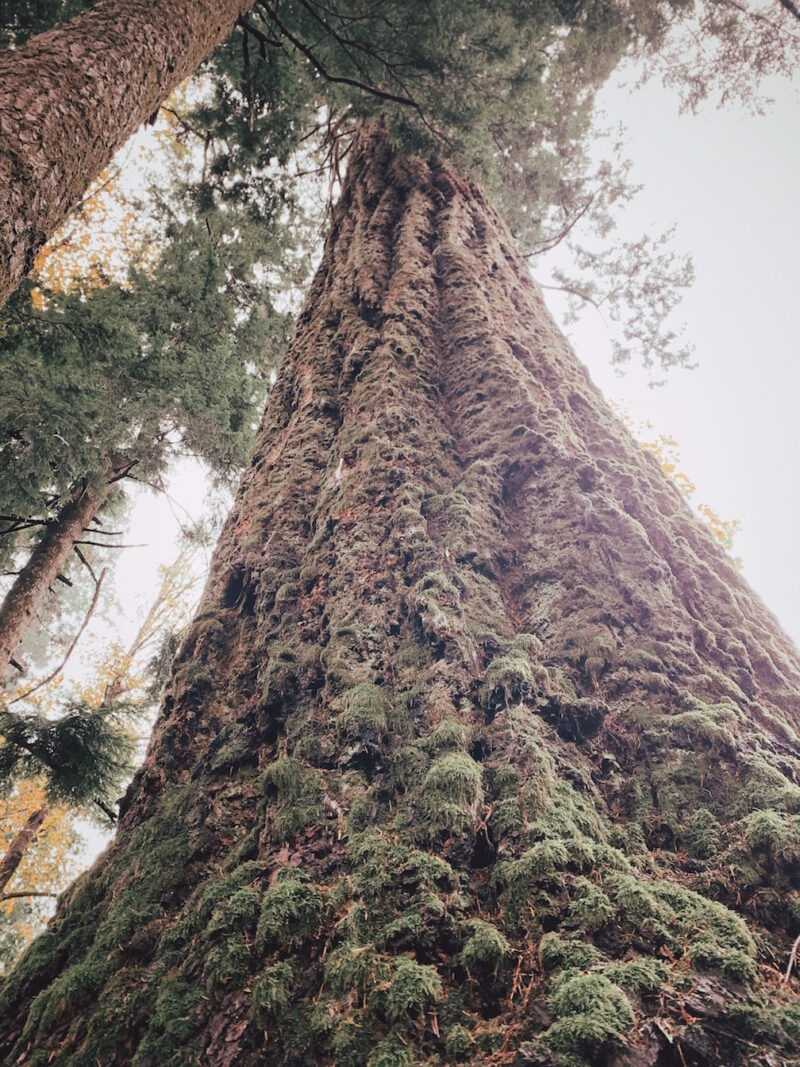
On the descent from our expedition, John and I talk a little bit less and instead I consider the weight and example Sumas Mountain must set for other areas in British Columbia, Canada, and the world.
There are moments in history, where decisions are made that decide the fate of a place. Like a wave crashing into the seaside, we can let the water wash over an area and change it with little evidence of what came before. This is the reality of Sumas Mountain today. The story of its history is being severed from what it was, from who was here, and from what it could be. The mountain itself is not gone; it has not died, yet parts of it have been torn out by logging, subdivisions, mining, and a general pillaging simply for what it can provide for profit. It is alive, but the light within is fading. It is a fragile ecosystem, in the way it breathes and moves, and is in danger of decapitation, never to be resuscitated.
Each morning as fall turns to winter, and the deciduous trees loose more of their leaves, exposing the grey branches beneath, when I try to capture the peace and beauty of this mountain, and remember the remnants of what was, I am often shaken into reality by the sound of growth that never seems to end. From the house on my family’s property, I hear the rock quarry digging into the lungs of the mountain. The memory of that profound silence in the grove of the old growth trees becomes dim as the sound of modern expansion explodes into my consciousness. Louder. Louder. Louder. They blast. The house shakes; bottles and glasses ting ting ting. Silence for a moment. Then their machines continue to grind and crunch and move about on the broken face of this place. It can almost be confused for the crashing of waves, but we are far from the ocean, and the beeping of trucks, growling of machines, and blasting, make it clear that there is nothing natural about these sounds.
In walking on the trail behind my family’s property in those final days of fall, I come to the edge of the forest. Beyond it I can see the rock quarry. There is a great empty space leading up to the expansive grey whose ashen shade filters into the muted sky above, which bends above me and folds into the the empty arms of naked tree branches. The more mountain that is dug and removed, the larger the chasms become between what was and what could be, and the cold greyness of progress grows ever more expansive.
*
The land is what’s left
after the failure
of every kind of metaphor.
— Christine Lowther

Winter
On the South West Coast of Canada, winter is often cold, rainy and grey. On Sumas Mountain, if we are lucky enough to get snow in December, or January, or February, and the gravel mines aren’t running, there is a quiet that falls over everything, bringing peace to the otherwise obtusely noisy days.
It is inevitable, though, that the white cool snow will turn brown and dull, and the lustrous sheen of a crisp winter becomes saturated with notorious West Coast rain. The mine runs, grinding, crunching, beeping, and blasting; spewing grey dust. On those days, the magic of winter fades and the reality of the mountain as a resource and space to grow up, up, up, settles farther in. The sound from the mines and roads and houses seeps into the winter forest, reverberating off stark trees. With no lush green summer to dull the sound of progress, I am reminded on these walks through the wood that change is here. It has arrived in a ruthless way that endangers the spirit of this place, where little or no remnant of what it was will be left behind.

Sumas Mountain goes back to the lives of the Indigenous people of the Sumas First Nation, whose ancestors populated the area for thousands of years before I or anyone else showed up, staking an illusive claim on a corner paradise that really belongs to no one.
The original custodians of the mountain, the valley below, what was Sumas Lake and the surrounding marshlands and rivers, were the Sema:th people. Their story, as told by Elders, counsellors, and memory keepers, carries back over ten thousand years ago, beyond the history of the flood that came to this land and helped to carve it into what it is today, leaving pockets of water and people all over the Fraser Valley. It is not only my story, and the Sumas Mountain I know that is threatened, it is that of the Sema:th people’s story as well.
Chris Silver, a member of the Se:math First Nation Counsel, agrees to speak with me over the phone as a dusting of snow falls from a dark winter sky. With a deep and methodic tone, embracing in his voice the way stories were told by his ancestors, he begins the tale of the Sema:th people and Sumas Mountain.
A man who could see the future came up the river to the valley and spoke to the people. He told them that the waters were going to rise. He told them that a great flood would drown the people. He told them, there was only one chance for survival. The people must carry their largest canoes to the top of the tallest mountain, where there was fresh water and bountiful food, and tie it to a great rock with the strongest rope. That mountain, was Sumas.
Those who chalked the man’s tale to trickery and foolishness, or did not secure their canoes in the right place with the strongest rope, disappeared. Some say they were lost in the waters. Others say they floated off to new lands and developed new groups of peoples. Those who stayed and listened to the man’s instructions, survived.
As the water level lowered, the people slowly moved back down the mountain. The people sought cover in the Thunderbird Caves along the way. When the remainder of the floodwater receded, some people went in their canoes a little bit north or a little bit south. Those who were left in the valley below Sumas Mountain, became known as the Sema:th people.
This is the story of the people of Sumas Mountain.
Sumas has been integral to the protection and survival of its people for over 10,000 years.
While they more commonly lived closer to what was Sumas Lake in the valley below, in and among marshland, the mountain housed them in times of struggle and flood and unbearable populations of mosquitos. It protected them during battles and storms. It fed and clothed them. It had been a sanctuary and a spiritual backdrop to tales and myths about great creatures who once populated this land, and about great events that helped to carve the valley into what it has become.
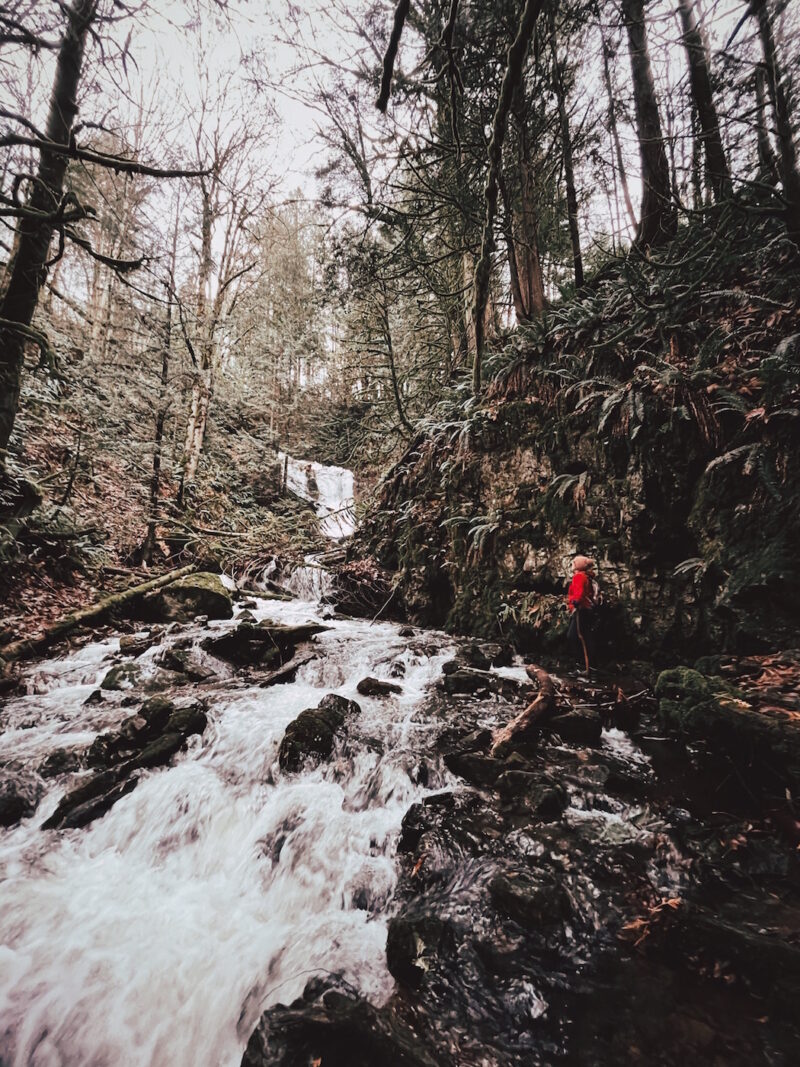
Sumas Mountain is central to every life within its gaze; past, present, and future. It is the pride and joy of the City of Abbotsford. It is a recreation playground and home to myself and others. It is still hunting grounds and a ceremonial place for the Sema:th people. It is also a site for mining rock and trees. Many of its water runs have been sold. It’s land is occupied and well used. It was once mined for rich clay, which gave birth to two clay brick factories in the area bringing people from all over Canada and the world to settle nearby. Sumas Mountain, since its beginning, has been the reason for people to be here. Instead of honouring it, we pillage it.
In speaking with John Vissers, about the mountain, he says “[The] remnant that we have here is, well it’s irreplaceable. It gives you a sense of space, of what it would have been like. We need to keep a remnant to remind us of what [this area] should look like or what it could look like, or what it might again some day look like.”
*
I heard a thousand blended notes,
While in a grove I sate reclines,
In that sweet mood when pleasant thoughts
Bring sad thoughts to the mind.
— from “Lines Written in Early Spring,” by William Wordsworth (1798)
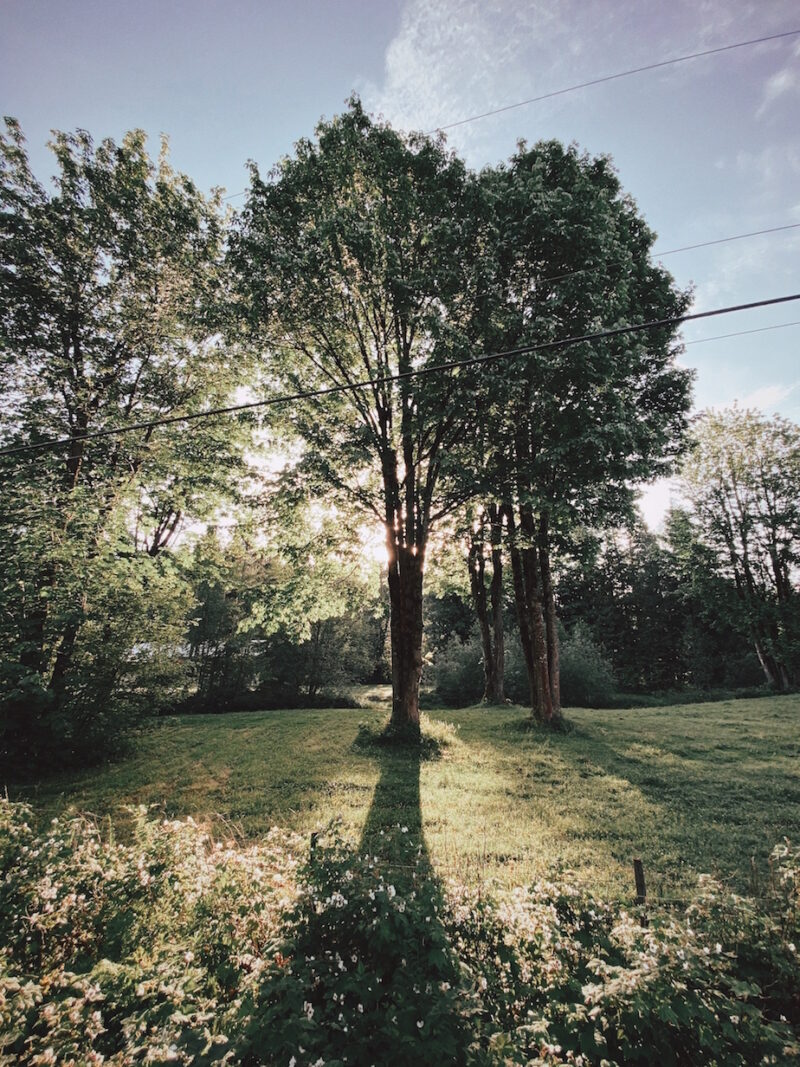
Spring
Each year and at every season I walk up the Centennial Trail to Lost Lake, but more often I find myself on the well worn trails behind my family’s house. While some areas stay the same, so much has changed. The land is overgrown with invasive blackberry bushes, drowning out the native breeds. The sounds of the forest are often crowded by gravel trucks, blasting, beeping, and grinding. There is even a geocache box hidden in the hollow of a tree by the creek; placed there by a modern treasure hunter and posted on the Web with coordinates for fellow geocachers to seek out. With the return of spring, after the snow melts to reveal the earth beneath, and green and pink buds pepper the paths once more, I wonder who else walked here in the decades before.
On a new section of the trail looping behind a neighbours house, I pass a split rail cedar fence post almost completely reclaimed by a young cedar tree. I recall the Sema:th people and the settlers. I recall the families and communities whose lives are captured in old photographs in black and white clothing against a forested backdrop. I recall those whose ancestors are embedded in the very earth I walk upon.
“What you find, depends on what you look for,” my father once told me. If I look hard enough, I can see the remnants of the lives that passed through this place. They walk here and hunt here. They hide here and explore here. They build here and they live here. They die here. I see what they thought in their time, what they may have known or imagined or dreamed. I see that some were part of the process that started us down the road toward the development we are facing today. Maybe it was always meant to be this way. Maybe growth and change is inevitable. Maybe, though, we get to decide what this place will become based on what we start looking for.
Coming up a hill, my feet stepping heel-toe on the dirt path, I smell the accretion of the seasons. The trees in spring are at once bare and blooming. The ground is strewn with the remnants of fall leaves that were trapped beneath winter snows, now giving way to new life. For a moment I am stationary and feel the earth beat beneath my feet. I close my eyes and hope to listen to the whispers of this place once more.
Silence. Then the chitter chatter of birds and chipmunks. The scurrying of something in the underbrush. A breeze teases the ends of hair. A thunderous boom. The crunch and grind of machines and gravel trucks mining for rock wails through the still stark forest. I can hear the beep beep beep of a reversing truck in the distance to the right and the pop pop pop of a nail gun building a house off to the left. The rising motor of a car accelerating up Sumas Mountain Road, and a motorbike, or quad, breaks sharply into the remaining quiet moments. Lawn mowers cry in the not so remote area beyond where I stand and music from some house over a hill accentuates the rest. The ambient noise is everywhere, carried along by the slightness of the wind or by rays of the sun, or simply by the sheer power of the sounds themselves. I wonder when it will overpower everything natural here, for good. I wonder when I will no longer be able to hear the chatter of chipmunks and squirrels, and when the wind in the trees will stop whispering to me and the owl simply leaves.
That day will come. I’ll be gone, but life will move on. I hope we will, though, be able to keep the remnants, and to look for something worth seeing and worth saving. I hope we will recall the power of remembering what came before and what helped us to be where we are now. When the trees stop whispering, I hope they still stand tall and proud, waiting for a time when their voices can be heard again; as remnants to the greatness of this place and the keepers of memory to those forgotten ways of being.
*

Natalie Lang is a teacher and writer. She is also currently a master’s student in the GLS (Graduate of Liberal Studies) program at SFU. She is based in Abbotsford, BC, where she teaches literature at Rick Hansen Secondary, and lives in a renovated barn in the heart of Sumas Mountain. Editor’s note: Natalie Lang has reviewed books by Dave Doroghy, Sheena Kamal, Jae Waller, carla bergman, Sonnet L’Abbé, Larry Hannant, Tanya dePape, Emily Lycopolus, Alicia Tobin, and Cait Flanders for The Ormsby Review. She has also contributed “A letter to William Wordsworth, my favourite wordsmith,” to Letters from the Pandemic.
*
The Ormsby Review. More Books. More Reviews. More Often.
Publisher and Editor: Richard Mackie
The Ormsby Review is a journal service for in-depth coverage of B.C. books and authors. The Advisory Board consists of Jean Barman, Robin Fisher, Cole Harris, Wade Davis, Hugh Johnston, Patricia Roy, David Stouck, and Graeme Wynn. Scholarly Patron: SFU Graduate Liberal Studies. Honorary Patron: Yosef Wosk. Provincial Government Patron since September 2018: Creative BC
“Only connect.” – E.M. Forster
*
References cited and consulted:
Cameron, Laura. Openings. London: McGill-Queen’s University Press, 1997
Dickinson, Emily. Collected Poems of Emily Dickinson. Chatham River Press, 1983
Dadalt, Wendy. Personal Interview. 31 October, 2020
Didion, Joan. Slouching Towards Bethlehem. New York: Farrar, Straus & Giroux, 1968
Frost, Robert. The Poems of Robert Frost. The Modern Library. Random House, New York, 1946
Lang, Breanna. Personal Interview. 10 October, 2020
Lang, Rick and Sandy. Personal Interview. 5 October, 2020
Lowther, Christine, and Anita Sinner. Writing the West Coast: In Love With Place. Ronsdale Press, 2008
Pierre, Nora. “Between Memory and History: Les Lieux de Memoire.” Representations, Spring. No. 26, Special Issue: Memory and Counter Memory. pp.7-24. University of California Press, 1989
Reimer, Chad. Before We Lost the Lake: A Natural and Human History of Sumas Lake. Caitlin Press, 2018
Riggins, Lorette, and Len Walker. Heart of the Fraser Valley: Memories of an Era Past. Matsqui Centennial Society: Abbotsford Printing Inc., 1991
Silver, Chris. Personal Interview. 1 November, 2020
Sturken, Marita. “The Wall, the Screen, and the Image: The Vietnam Veterans Memorial.” Representations of Summer. No. 35, Special Issue: Monumental Histories. pp. 118-142. University of California Press, 1991
Sumas First Nation. History – Sumas First Nation. 2020, Accessed 20 Oct 2020
Vissers, John. Personal Interview. October, 2020

9 comments on “1071 Remnants of Sumas Mountain”
I cherish ‘your’ exquisite mountain too, Natalie. I come and hike there by myself fairly regularly to admire this unusual ‘natural island’ in the midst of the Fraser Valley and to soak up the silence in the densely forested canyons, and of course have noticed the constant ‘creep’ into its quiet nature, the clearcuts in the middle and the crowds in the summer months. I hope that one day, atv’s and other motorized vehicles will be banned altogether. Perhaps the FMCBC, the Federation of Mountain Clubs of BC, can be helpful in advocating with you: they’re in constant contact with Provincial Ministries against motorized ‘sports’ encroaching on natural areas and wildlife habitats. At the very least they should be aware of the issues in your area. The mountain is happy with residents like you. Mariken (GLS ’01)
Every time I read this story, I find something new to think about and I find energy to go for a walk.
Well done, beautifully captured.
Thank you for your haunting and poignant story, Natalie. Not only do you bring voice and value to the old soul of the land, you educate the reader about the intricacies and interdependence of wild ecology. Your beautiful clarity with language invites the reader to understand the delicate connections with nature that many of us will remember from childhood. As the land disappears, we grieve and we cherish what remains…like you.
Thank you for bringing advocacy and protection to the deepest values of ancient cultures, and for telling the story through your sensitive perceptions of your own family and farm…
Lee Reid
Nelson, B.C.
Hi Lee,
Thank you for your kind note. It is more appreciated than you know.
~ Natalie Lang.